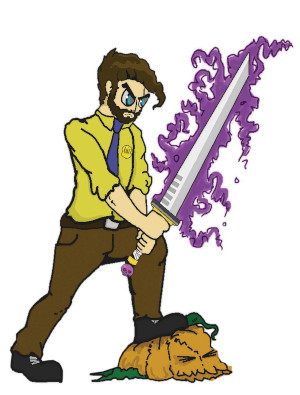LENS
More Than Just a Game
 Cleveland Institute of Art student Ocean Young created this investigator with paranormal powers for the game "Fight or Fright," which he co-developed with other students last fall.
Cleveland Institute of Art student Ocean Young created this investigator with paranormal powers for the game "Fight or Fright," which he co-developed with other students last fall.
Class name: Advanced Game Development Project
Taught by: Michael Fu, PhD (GRS '06, '11, electrical engineering and applied physics), assistant professor of electrical engineering and computer science since fall 2016. The class was created and taught initially by Marc Buchner, PhD, an associate dean and associate professor in the same department.
What makes it intriguing: Taught with faculty from the Cleveland Institute of Art (CIA), the class emulates real life in the commercial game-design industry. Case Western Reserve students work in interdisciplinary teams with CIA students, who are majoring in game design and skilled in music and animation, to produce an online game. In a final public "Arcade Day," industry professionals evaluate each game.
The one-semester course takes students through the complete game-design process: brainstorming, designing, prototyping, play-testing, bug removal, coding refinements and even marketing (they have to design a logo and game description). Fu said bringing students together in a multischool, interdisciplinary course is "a luxury we have, as CIA is just down the street."
Because students work in teams with about 10 others who often are total strangers, they must learn to master "soft" skills such as planning and executing the project (including translating a paper concept into reality and managing a realistic plan to produce a five- to seven-minute game), bird-dogging all of the details at each stage and communicating—including giving each other constructive criticism (which sometimes can feel harsh) and accepting feedback (ditto).
Some students have struggled with the social skills. ("Lots of drama," Fu observed.) If they learn to work with other students, he noted, they complete the class not only with a working prototype for their portfolio, but also valuable experience and self-awareness. Fu ensures that students know "it's OK to make mistakes" because they can experiment with fixing problems (in both engineering and human interaction) in a safe environment. "That's what school is about," he said.





